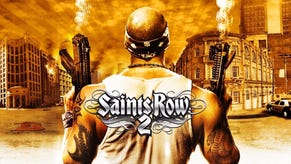Face-Off: Saints Row: The Third
Which format is the saint, and which is the sinner?
| - | Xbox 360 | PlayStation 3 |
|---|---|---|
| Disc Size | 7.0GB | 6.95GB |
| Install | 7.0GB (optional) | 4035MB (mandatory) |
| Surround Support | Dolby Digital | Dolby Digital, DTS, 5.1LPCM |
Grand Theft Auto may be taking a more serious tone as the series matures but the Saints Row games are moving in the opposite direction. In-depth characterisation and an intriguing story are left behind in favour of what made the earlier GTA games so much fun to play in the first place - that is, being able to mess around in an open-world playground where realism is given the elbow in favour of all-out insanity.
Saints Row: The Third also represents a large graphical improvement over the second game in the series. The change in art direction in this latest instalment in combination with more restrained use of normal mapping and specular highlighting on some surfaces creates a more realistic look to the environments. A closer look at the texturing also reveals quite a bit of subtle detailing in many places: the small cracks that appear on the road and pavements, and the degradations manifesting on the walls of old buildings found throughout Steelport.
Other areas have also seen similar upgrades: animation is smoother and flows together better than in the previous game, and there's a noticeable increase in the amount of post-processing effects in play, particularly in the more heated cut-scenes, where screen distortion effects and motion blur can be quite prevalent.
That's not to say things are perfect. As with past Volition titles, the open-world engine used in Saints Row: The Third really seems to struggle dealing with long draw distances and subtle detail: there's noticeable object pop-in and a string of performance issues on both platforms which deliver an experience that isn't quite as refined as we'd hoped for.
More on that later, but first we kick off with a look at our head-to-head video and triple-format 720p comparison gallery, which reveals a welcome boost in resolution on both formats over the series' last outing.
Saints Row: The Third renders in native 720p on both platforms and the difference is night and day compared to its 640p predecessor: as you would expect from such a leap, presentation is much, much sharper. The anti-aliasing set-up remains as it did in Saints Row 2: multi-sample anti-aliasing (MSAA) is present on the 360 with quincunx (QAA) being used on the PS3.
The downside with using QAA comes in the form of trading clarity for more edge-smoothing, as the technique blurs both edges and texture details - jaggies are less visible on most surfaces (with 4x MSAA type coverage), but the trade-off is that sub-pixel details in the distance aren't fully resolved and fine detail in the artwork is impacted by the additional blur. Also, as a consequence of this, some of the specular highlights don't appear quite as pronounced.
In fairness, the use of quincunx isn't exactly a deal-breaker. The art style in Saints Row: The Third actually works quite well with this form of anti-aliasing - it's only when things start moving away into the distance you get the feeling that the smoothing solution employed is scrubbing away a little too much in the way of fine detail. Despite this the actual artwork itself appears to be identical between consoles.
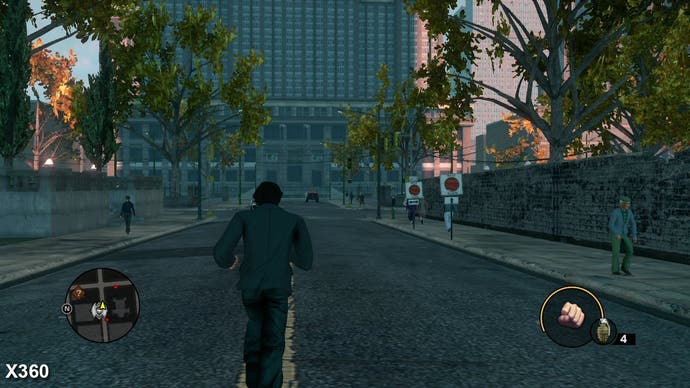

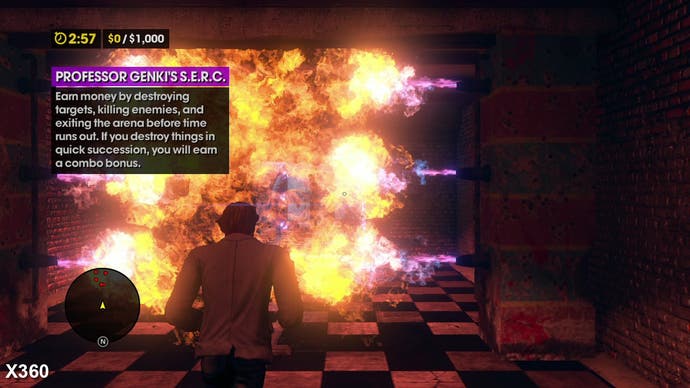
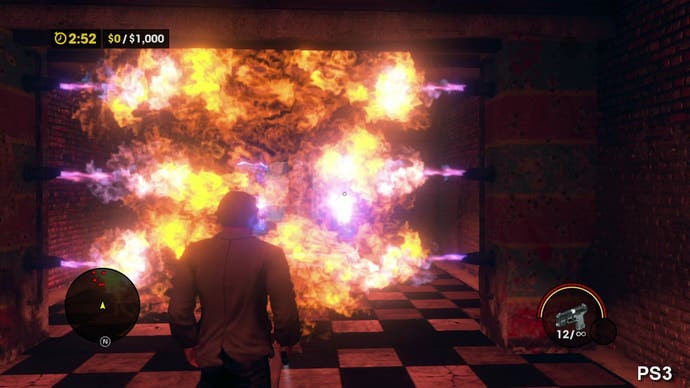
Image Quality
There are other factors which also affect the quality of the visuals in the PlayStation 3 game, though not to the same extent as the QAA blur: the level of anisotropic filtering seems to take a hit, resulting in additional texture blur in the distance, and the alpha buffers are rendered in a lower resolution causing smoke and fire effects to look considerably flatter (some lack bilinear filtering as well, resulting in visible pixelation). This also impacts upon the clarity of the foliage dotted around the city - not only are the trees less detailed, there's a real sense that the additional blur from the upscaling process in these elements adds to the game's already softer look.
The streaming in of art assets is also very noticeable on both versions of Saints Row: The Third. Higher quality LOD (level of detail) models are loaded in quite close to the camera, texture pop-in is frequently noticeable, and we see that foliage LOD is also pretty aggressive. While most of these issues are equally present across both consoles, we find that foliage LODs are a little stronger on the PS3, further giving the impression that things aren't quite as polished as we would have liked to have seen.
In other areas we see a PlayStation 3 advantage: while both SKUs feature the use of camera-based motion blur, the effect looks slightly smoother on the Sony platform, while in some shots per-object blur is strangely absent from the Xbox 360 game. Implementation of the latter on the PS3 is rather interesting: some shots show the effect being rendered in lower precision, although this has no real-world impact on the visuals whilst playing. Perhaps Volition has implemented a solution whereby the effect is dynamically adjusted for performance reasons.
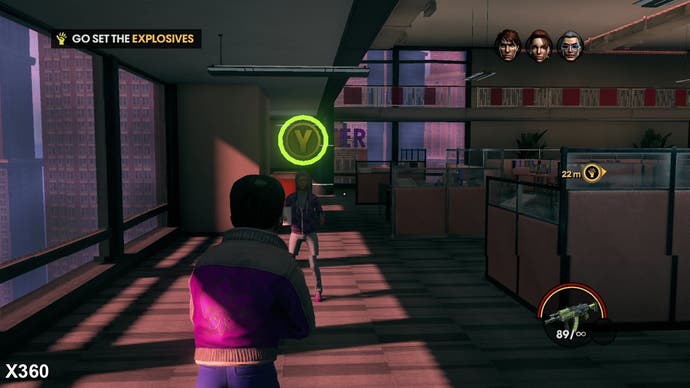
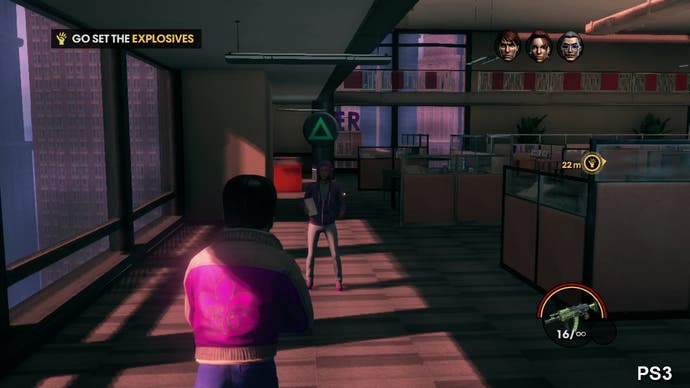
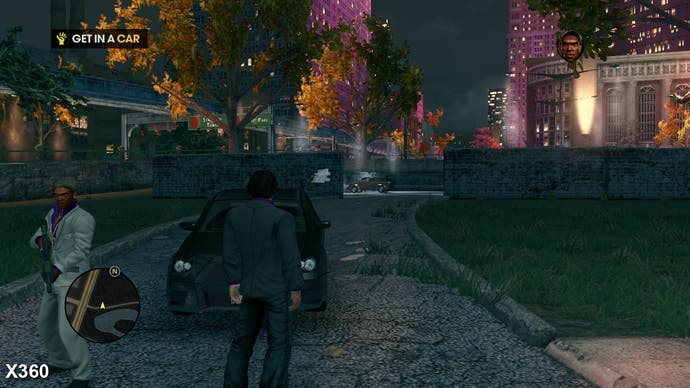
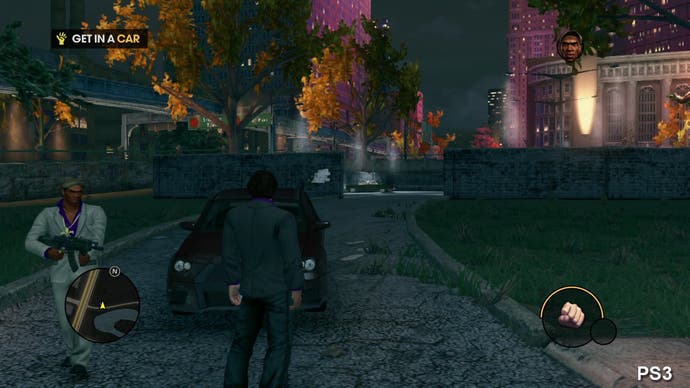
There's no time-of-day dynamic lighting in this game (instead we see scripted, jarring transitions) but real-time lighting is still clearly present throughout the game, working in conjunction with dynamic shadow maps which help illuminate the world. Saints Row: The Third uses a shadow cascade (with lower resolution shadows manifesting the 'deeper' you look into the scene), but it looks as though the PS3 version has lower resolution shadows rendering closer to the player compared to the 360 version.
In some of our shots you might notice that the odd light is source missing on the PS3, but this is somewhat misleading - the light is only absent because we accidentally knocked over a lamp post or two during gameplay. Due to the demands of lighting an open-world, few light sources actually cast shadows over environmental objects, which can lead to things looking quite flat in places. However the use of screen ambient occlusion (SSAO) on both versions helps to provide extra depth, which partially mitigates this.
Performance Analysis
In terms of performance we see that frame-rates are higher than they were in the last Saints Row game but there are still a number of issues impacting quality on both versions. Let's start with a performance analysis comparing a mixture of gameplay scenes. Here we've put together matching clips covering driving, shooting, and other action sequences in which we try and stress-test the engine. In all honestly we didn't need to do very much as performance varies wildly even across a basic run of play.
During gameplay, Saints Row: The Third runs with an uncapped frame-rate on both systems. The PS3 version is solidly v-synced at all times , using triple-buffering to ensure that no torn frames are displayed, while the 360 game runs without it. As such we see near constant screen tearing on the Microsoft platform which becomes very noticeable during gunfire and hectic scenes or during exploration of the city in more detailed areas - turning corners when driving almost guarantees to result in torn frames being displayed, and is very noticeable.
In terms of frame-rate, we find that performance is closely matched between both formats, and that outside of certain scenarios on the PS3, the game frequently fluctuates between around 24 to 32 frames per second on both systems: turning corners whilst driving in more detailed areas of the city, explosions during gunfire, and large set-pieces all cause both versions to similarly lose smoothness. In some indoor shoot-outs we see performance take a dip on the PS3 for extended periods, with frame-rates in the 20s, while the 360 adheres more closely to 30FPS, giving a more responsive feel to the controls.
By far the biggest issue is the fact that tearing and frame drops often happen at the same time on the 360, and as we saw recently in Assassin's Creed: Revelations, this particular combination is not a pretty sight - not only is controller response affected but image consistency also gets frequently thrown out of the window, with highly visible tears. Elsewhere, on both formats some scenes push the engine a lot harder and this has a devastating impact on how well the game plays - in the tank section we witnessed an average frame-rate of around frankly poor 18FPS, making this part of the game barely playable at all.
So when it comes to gameplay PS3 has the edge, mostly keeping up with the 360 game but with the added benefit of maintaining image consistency. While the few heavier drops in smoothness in some areas do affect the playability of the game, these instances are hardly frequent and the absence of screen tearing is a worthy trade-off in this regard.
Curiously, a look at the 'display' menu reveals that the option to toggle v-sync on or off is present in the 360 game, but absent on the PS3 (would you really want to turn on tearing?). For the Microsoft platform, the default set-up shows that v-sync is enabled for the in-engine cinematics and disabled for gameplay. Since screen tear can be a real issue at times on the 360 we were intrigued as to the effect of enabling v-sync would have on performance - would improving image consistency be worth the potential sacrifice in terms of raw smoothness?
V-Sync Options on Console - a Good Idea?
Had Volition taken a more carefully approach to its implementation, it might have been worthwhile. But as it stands there's very little to gain in eliminating tearing from the 360 release at all, and plenty to lose in terms of performance and controller feedback.
On the one hand the lack of tearing is very welcome, but going down a double buffered route in implementing v-sync comes with a heavy cost: when the frame-rate drops, we are often left with a sustained 20FPS. Effectively, the game engine is waiting for the next screen refresh to begin before it displays the frame, stalling the GPU in the process, and thus heavily impacting on the frame-rate. There are times when the 360 keeps up with the PS3, maintaining a similar level of smoothness with no tearing at all. However, this is often short-lived as when the engine begins to struggle the level of smoothness takes a dip back down again.


The shots above give you a very good insight of how well the game holds up when image consistency is maintained at the expense of raw smoothness - and as we've already discussed it's not a pretty sight. Clearly, running without v-sync is the best way to play the game on the 360. The frame-rate is smoother and this translates into more responsive controls for the player, so we would recommend leaving the 360 game on its default settings.
A look at the cut-scenes in the game gives us an opportunity to see how well the engine performs when rendering like-for-like sequences, and it also shows the only time in the game where Volition wants us to see a v-synced presentation on the Xbox 360.
As we saw when analysing gameplay clips, double-buffering is in effect on the 360 and triple-buffering on the PS3. This leads to a familiar outcome, with stressful scenes causing the frame-rate to drop down to 20FPS on the 360 when the engine cannot keep up with rendering a new, complete frame with each screen refresh. On the PS3, most frame drops are fairly incremental and have far less of an impact on overall smoothness. At times both versions perform identically - frames are dropped at similar points and smoothness is lost - but by and large it is the PS3 that claims a noticeable advantage here.
When looking at performance as a whole Volition's choice to either run without v-sync on the 360 is somewhat perplexing, seeing as any performance advantage with the former results in heavy screen tearing, while v-sync engaged can really impact the frame-rate.
What we don't quite understand is why Volition only offer the two extremes here, rather than a more logical 'third way'. Many developers cap at 30FPS and drop v-sync when rendering runs over budget. Based on what we're seeing, we can't help but think that this would have stabilised Saints Row: The Third and provided more consistent controller response with tearing when only absolutely necessary. With things the way they are, the bottom line is that performance is preferable on the PlayStation 3 but at the expense of some image quality.
Why PC Offers The Best Experience
Thankfully, anyone with a decent gaming PC should be able to 'power through' any limitations of the console versions. Taking advantage of far more powerful hardware to deliver smoother frame-rates and better image quality is expected, but in the case of Saints Row: The Third playing on computer results in a welcome graphical upgrade all around, building upon the console base and in turn having a beneficial impact on how enjoyable the game is to play. Becoming immersed in the world Volition has created is a much easier thing to do when technical issues aren't getting in the way of the experience.
We chose the DirectX 10/11 options before setting the resolution to 720p (matching the consoles) and then dialing up all graphical options up to their very highest settings. Above, we have our 360 and PC head-to-head video, while you can see just how well the PS3 version fares up against the PC game in a separate presentation.
Running at the same resolution as the consoles, the PC version offers up a far cleaner and clearer visual experience. The use of 8x MSAA manages to suppress a great deal of the 'jaggies' - though not all, as sub-pixel issues can clearly be seen - while the artwork appears visibly more detailed in some scenes. In most cases however, texture detail appears to be designed around the console spec: the main difference here comes with the use of higher levels of anisotropic filtering, which delivers much more clarity to the artwork in the distance. In this respect, our PS3 and PC head-to-head video serves to show just how far ahead the PC version is with regards to image quality.
Elsewhere, the level of detail visible at any given time is also noticeably higher, helping to create a better impression of an intricately detailed cityscape. The game's streaming system is much less aggressive, with mip-map switching and general LOD transitions occurring much earlier on, thus significantly reducing the amount of object pop-up as you explore the environment. Foliage is more detailed, and there is slightly more of it dotted about across the city too.



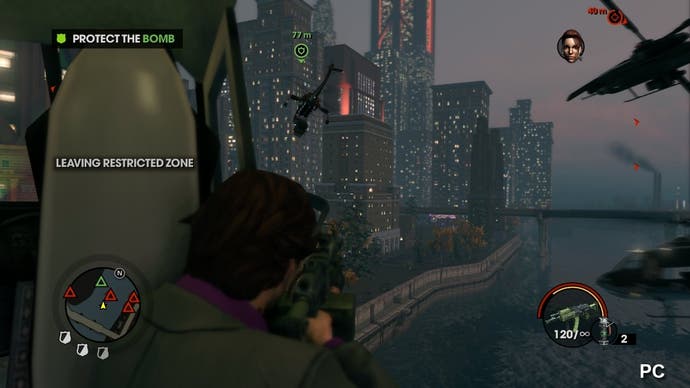
We also see that a number of effects have been given a boost. Motion blur features a higher precision implementation which preserves clarity without lowering the amount of screen distortion present (perhaps looking more than a touch overblown in the cut-scenes). Object blur is also present, but is strangely reduced in a couple of places, similarly in line with the 360 version.
The use of SSAO is also much stronger - although this can be toned down if you want - which provides the environments with a much greater sense of depth over the console SKUs. However, the way in which the effect manifests around the characters are somewhat displeasing: a large black halo appears when they are in close proximity to the scenery, which can be seen from far away. In general we prefer SSAO to be much less dominating on the overall presentation.
Looking at the shadows, higher quality filtering is in play and we don't see the same harsh shadowmap cascade transitions as on the consoles. This in combination with the other visual refinements really helps to create a noticeably better looking game all round - even if much of the artwork is largely identical, you get the feeling that every ounce of detail is being fully fleshed out.
The fact that it is possible to run the game at much higher frame-rates than the console versions also helps: while we managed between 30 and 60FPS on our Core i5 and GTX460 combo, with smooth transitions between drops (much like Call Of Duty on consoles), we found that just having a locked 30FPS provided a very welcome 'night and day' difference compared to the uneven experience you get on both consoles. Those looking for more consistent 60FPS experience will need a more powerful set-up, perhaps something like a GTX570 when running in 720p.
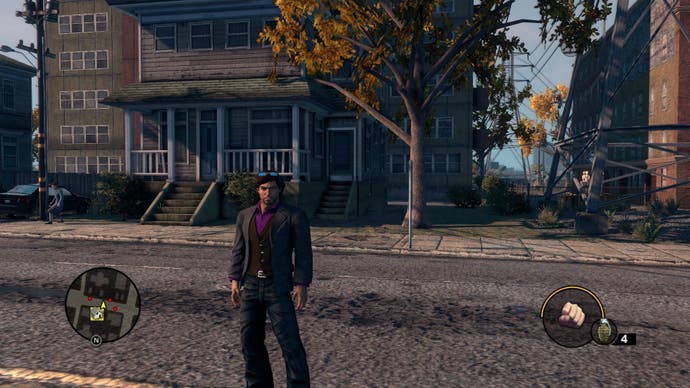


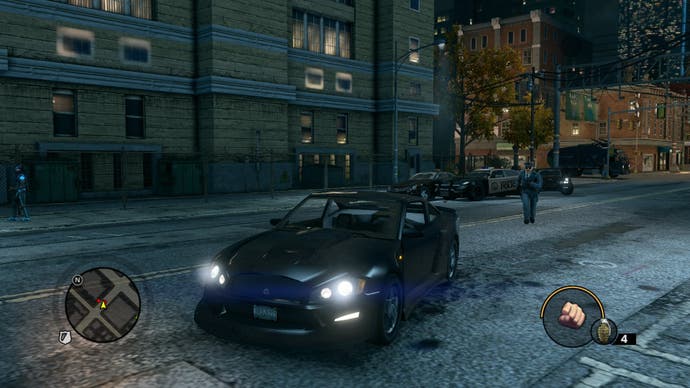
In a like-for-like comparison with the Xbox 360 and PlayStation 3, Saints Row: The Third really shines in 720p, but further upping the resolution to 1080p also reaps some tangible rewards. While many of the art assets don't really scale up along with the resolution, the additional sharpness on offer is very welcome, and in combination with the increased draw distance (compare to the consoles) and higher levels of AF you are seeing, it's clear that the overall experience is a considerable jump over what we see on console.
It's no surprise to find out then, that the PC version then is easily the one to go for if you've got access to a fairly decent computer set-up. The vastly reduced pop-up, extra clarity, better edge smoothing and superior frame-rates makes ploughing through Steelport's underworld goons far more enjoyable. That said, there's still a lot of fun to be hand with the game on consoles, so long as you can ignore the vastly inconsistent frame-rate on both systems, the excessive tearing on the 360 and the drop in image quality on the PS3.
When it comes down to the final analysis of the console versions it's all about compromises when deciding which one to go for, but if we had to choose between the two we'd take the PS3 release for the lack of screen tearing, seeing as this has far more impact on your enjoyment of the game than the drop in image quality. Alternatively, if the 360 version is your only option, by all means pick it up instead - the content is identical between releases and most of the fun comes from the madcap antics on offer. The technical issues - while unfortunate - aren't deal-breakers.








